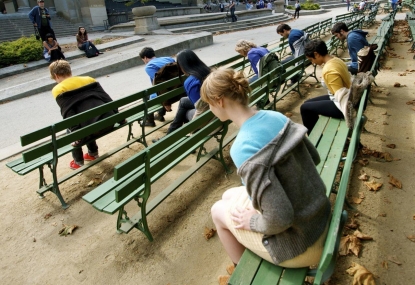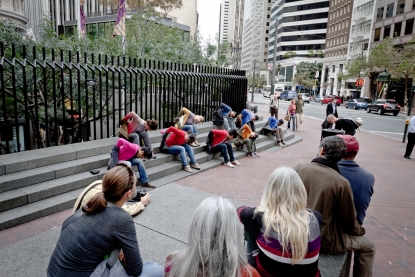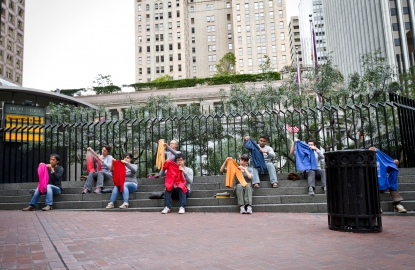Feature: Reviews
Fold {Live}
On a Sunday afternoon in September, eight people took seats on benches at the southwestern corner of Golden Gate Park's Music Concourse. In slow-motion unison, they removed their jackets, sweaters, and pullovers, carefully folding and smoothing each article of clothing before taking off the next. A crowd of onlookers gathered. Some smiled bemusedly and cast furtive glances at their fellow spectators, hoping perhaps that someone might tell them what they were watching. Others carried on quiet conversations or snapped photos with their cellphones. When the eight undressers were down to their undershirts, they reversed the process, methodically replacing each layer. After they donned their jackets, they stood and dispersed.
This was the first of four site-specific performances in Golden Gate Park and downtown San Francisco, all part of "Fold {Live}," an ongoing project by San Francisco-based new media artist Surabhi Saraf. Saraf describes "Fold {Live}" as a "humanized" reinterpretation of "Fold," a hypnotic video installation she created in 2010. The video work highlights the aesthetic and ritual value of mundane human activity. To create it, Saraf filmed herself folding laundry, then multiplied this footage into an 8" x 12" grid and manipulated the timing of each of the 96 frames such that the snap of a sheet moves wave-like across the screen and the folding of a scarf produces a fluctuating field of lights and darks. The artist's background in choreography, music, and sound art informs her approach to video-making, and Saraf describes her preparatory work for "Fold" as a "visual score [...] defining the flow, the pattern, and the structure of [the] composition." Her arrangements of color and movement are captivating, but the video also appeals to the ear; the rustle and pop of the fabrics create a natural rhythm that complements the striking visuals.
In May 2011, Saraf debuted "Fold {Live}" at Root Division. Twelve volunteer performers sat on plastic chairs, each with a hamper alongside, and folded laundry. Saraf’s choreography is effective, but even though the folders excelled at their labor and the live aspect of the work was winning, the first rendition of "Fold {Live}" didn't succeed in transmuting the everyday into the sublime as effectively as "Fold." The gallery setting indicated to the assembled crowd that they were in the presence of fine art, and viewers therefore noticed whenever the performers were slightly out of sync. The special potency of the video installation is a result of Saraf's editing, and the "Fold {Live}" staging, which necessitated less directorial and editorial control, suffered in the gallery context, where modest imperfections matter.
Saraf had no more control over the four "Fold {Live}" performances in September and October 2011, but public spaces are less burdened by critical expectations. While some of the people who made up the audiences at the Music Concourse, the Polo Field, the Federal Building courtyard, and the corner of Montgomery and Market Streets knew what it was they were witnessing, most did not. The majority of the viewers were pedestrians whose curiosity compelled them to watch for a few minutes, sometimes longer. The serendipity of the encounter informed their experience of the performance. Whereas viewers at Root Division observed art gallery etiquette (i.e., stood quietly and looked thoughtful), the public venues allowed the audiences to be at ease, as enthusiastic or dismissive as they liked. (At Montgomery and Market, a boyfriend grunted and quickened his pace as his girlfriend protested, "But I want to see what they're up to!" An elderly woman waiting for the crosswalk light to change decided that "It must be a protest!") Those who did choose to watch were granted an opportunity to consider the significance of the performers' familiar, if incongruous activity. The public performances of "Fold {Live}" turned a workaday chore into a meditative, ceremonial act and invited the viewer to experience a perceptual shift. The next time he finds himself folding his family's clothes, perhaps he'll recall the curious ritual he happened upon in Golden Gate Park and will more favorably reassess his own labor. Saraf can't know whether this will happen, but by sharing "Fold {Live}" with the community at large, she’s made it possible.



